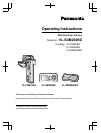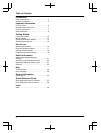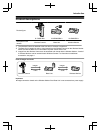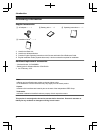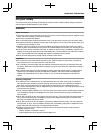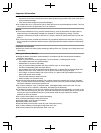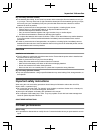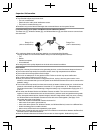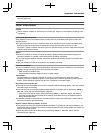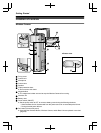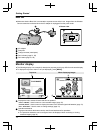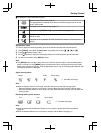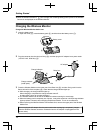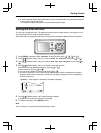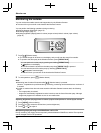
– If the Base Unit or the Wireless Monitor has been exposed to rain or water, or liquid has been spilled
in
to the unit, do not use a microwave oven to speed up the drying process of any parts of the unit to
avoid permanent damage.
– If the unit has been dropped or physically damaged.
R Do not place the unit in a microwave oven or other devices such as electromagnetic cookers. This may
cause heat or smoke to be generated, fire, or an explosion.
Medical
R Co
nsult the manufacturer of any personal medical devices, such as pacemakers or hearing aids, to
determine if they are adequately shielded from external RF (radio frequency) energy. (The unit
operates in the frequency range of 1.88 GHz to 1.90 GHz, and the RF transmission power is 250 mW
(max.).)
R Do not use the product in health care facilities if any regulations posted in the area instruct you not to
do so. Hospitals or health care facilities may be using equipment that could be sensitive to external RF
energy.
Installation and relocation
R M
a
ke sure to have sure footing when attaching or taking off the unit. Tripping over or falling down may
cause injury.
Battery pack (Wireless Monitor)
R Ch
arge the battery (included or recommended) in accordance with the instructions and limitations
specified in this manual.
R In order to prevent the risk of heat generation, fire, an explosion, or leaking liquids, do not:
– Use a battery other than the specified battery.
– Disassemble or reconstruct the battery.
– Carry or store the battery together with rings, bracelets, keys, or similar objects.
– Use the included battery pack with other devices.
– Use a charger other than the specified charger (Base Unit), or tamper with the charger (Base Unit).
– Dispose of the unit in a fire, heat up the unit, or get the unit wet with any type of liquid.
– Use, charge, or leave the battery near a fire or stove, or in places with high temperatures such as
places that receive direct sunlight.
– Connect metal objects to battery terminals.
– Heat the battery in a microwave oven.
R Exercise care when handling the battery. Do not allow conductive materials such as rings, bracelets,
keys, or similar objects to touch the battery, otherwise a short circuit may cause the battery and/or the
conductive material to overheat and cause burns.
R Do not open, puncture, crush, or drop the battery. A damaged battery must not be used. This can
result in the risk of fire, explosion, overheating, and leaking of the electrolyte.
R If the battery is leaking, do not come into contact with the electrolyte from the battery or let it get in your
eyes. This may cause injury to your eyes. Should the electrolyte from the battery get into your eyes, do
not rub your eyes. Immediately flush your eyes with clean water and see a doctor for medical
treatment as soon as possible.
R Do not remove the battery from its original packaging.
R Do not subject the battery to mechanical shock.
R Keep the battery out of the reach of children.
R Keep the battery clean and dry.
R Wipe the battery terminals with a clean dry cloth if they become dirty.
R Do not leave a battery on prolonged charge when not in use.
R Remove the battery from the equipment when not in use.
6
Important Information



